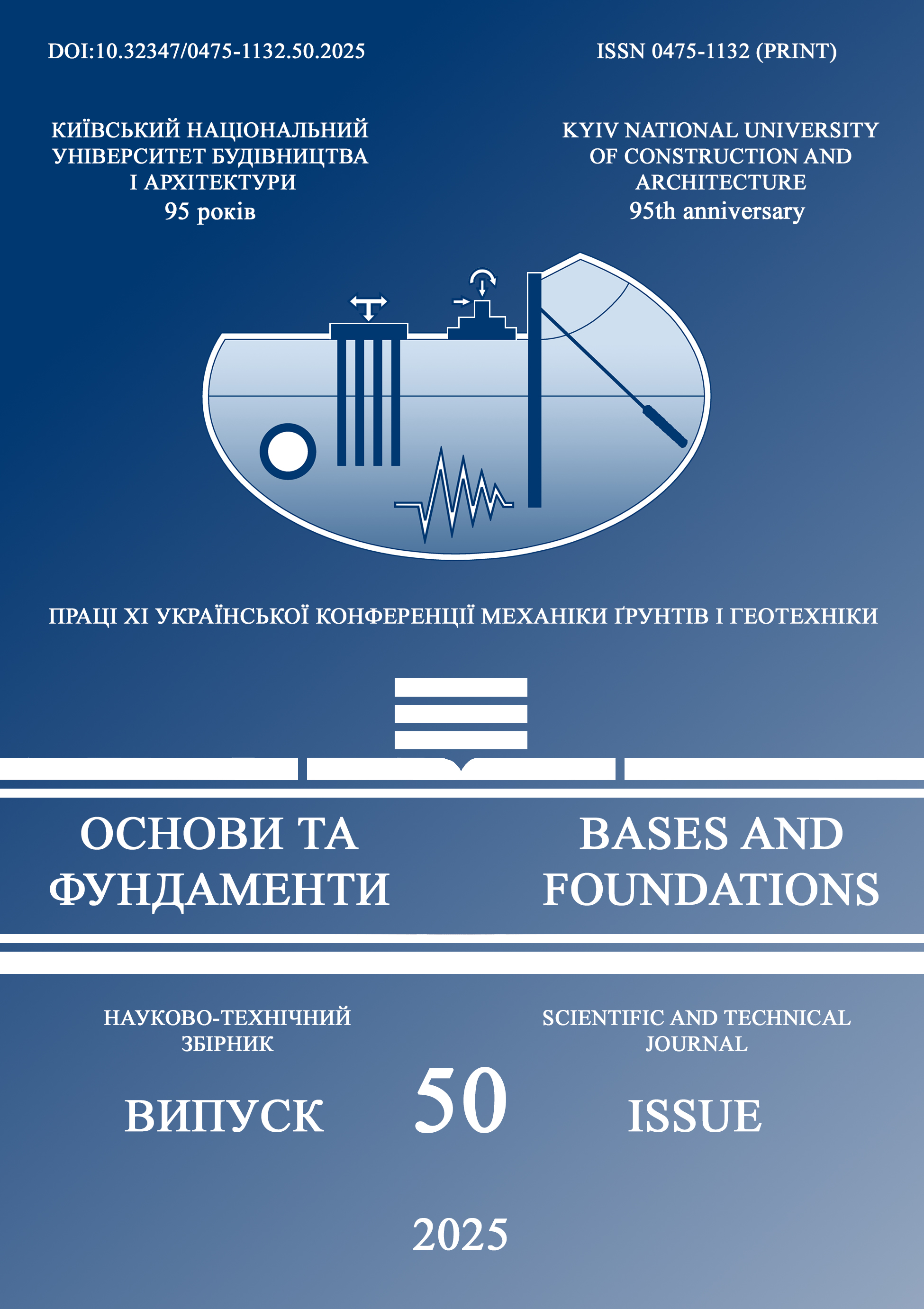Прикладання методу граничних елементів до механіки деформованих ґрунтів
Основний зміст сторінки статті
Анотація
У зв’язку з переходом сучасних будівель на каркасно-монолітну схему, будівлі ростуть вверх і вниз. Це збільшує тиск на основи і приводить до необхідності при їх проектуванні розв’язувати нелінійні задачі механіки ґрунтів, оскільки головною проблемою технічних систем є надійність. В останній час спостерігається явна тенденція підсилення теоретичних досліджень у фундаментобу-дуванні. Отримання надійних результатів моделювання в більшості випадків зводиться до використання нелінійних пружно-пластичних моделей, що базуються на теорії пластичної течії, дилатансійних співвідношеннях В.М. Ніколаєвського, І.П. Бойка.
Вітчизняна геотехніка знаходиться на шляху інтенсивного розвитку. Широко застосовуються числові методи, засновані на пружно-пластичних моделях. Руйнування дискретних матеріалів (до яких відноситься і ґрунт) проходить в результаті накопичення пластичних (залишкових) деформацій, що в граничному стані викликає розрив суцільності масиву в формі взаємного проковзування його частинок. Вплив пластичності проявляється в розвитку переміщень, перерозподілі внутрішніх зусиль. Міцність зв’язків в дисперсних ґрунтах набагато менша міцності самих частинок, а при відсутності сил зчеплення (пісок) основним фактором деформацій ґрунтової основи є сили контактної взаємодії і деформації пов’язані з переупаковкою частинок.
Основний напрям розвитку в будівництві – застосування нових, раціональних та ефективних конструкцій паль, які б підвищували їх несучу здатність, технологічність виготовлення та влаштування.
Низьке використання міцності матеріалу паль квадратного перетину – мала питома несуча здатність (25-60%) стримує техніко-економічний прогрес в будівництві та потребує використання нових ефективних та раціональних конструкцій паль. Впровадження паль із складною формою поперечного перетину є перспективним в цьому напрямку і описано в роботі (Малишев, 2011).
Не зважаючи на чималу кількість експериментальних досліджень паль складної форми поперечного перетину конкретних вказівок щодо особливостей їх роботи та розрахунку мало. Найбільш ефективними є палі перехресного перетину, двотаврові, таврові. Найменш ефективні – палі круглого та квадратного перерізу. Важливим є також питання урахування та неврахування заповнення ґрунтом об’єму між ребрами паль оскільки палі із складною формою бокової поверхні (таврові, двотаврові, хрестоподібні) мають різний характер ущільнення ґрунту навколо їх бічної поверхні та залучають до своєї роботи деяку ущільнену зону ґрунту, яка утворюється між ребрами паль при їх заглибленні, про що відмічено в роботі (Малишев, 2011).
Тому перевірка методики розрахунку несучої здатності та деформування ґрунтової основи за числовим МГЕ такого виду паль, статичним вертикальним навантаженням, є актуальною задачею.
Блок інформації про статтю

Ця робота ліцензується відповідно до Creative Commons Attribution 4.0 International License.
Автори, які публікуються у цьому журналі, погоджуються з наступними умовами: Автори залишають за собою право на авторство своєї роботи та передають журналу право першої публікації цієї роботи на умовах ліцензії Creative Commons Attribution License, котра дозволяє іншим особам вільно розповсюджувати опубліковану роботу з обов'язковим посиланням на авторів оригінальної роботи та першу публікацію роботи у цьому журналі. Автори мають право укладати самостійні додаткові угоди щодо неексклюзивного розповсюдження роботи у тому вигляді, в якому вона була опублікована цим журналом (наприклад, розміщувати роботу в електронному сховищі установи або публікувати у складі монографії), за умови збереження посилання на першу публікацію роботи у цьому журналі. Політика журналу дозволяє і заохочує розміщення авторами в мережі Інтернет (наприклад, у сховищах установ або на особистих веб-сайтах) рукопису роботи, як до подання цього рукопису до редакції, так і під час його редакційного опрацювання, оскільки це сприяє виникненню продуктивної наукової дискусії та позитивно позначається на оперативності та динаміці цитування опублікованої роботи (див. The Effect of Open Access).Посилання
Малишев, О.В. (2011). Статичні випробовування таврових паль в польових умовах. Тези доповідей НТК молодих вчених, аспірантів і студентів ч.1., 68-69.
Brebbia, C.A., Telles, J.C.F. & Wrobel, L.C. (1984). Boundary element techniques, theory and applications in engineering. New York: Springer-Verlag.
Mindlin, R.D. (1953). Force at a point in the interior of a sami – infinite solid. Physics. Colombia.
Ніколаєвський, В. Н. (1979). Дилатансія та закони незворотнього деформування ґрун-тів. Основи, фундаменти та механіка ґру-нтів. Збірник наукових праць, 5,. 29-31.
Бойко, І. П. (1985). Теоретичні основи про-ектування пальових фундаментів на пру-жньо-пластичні основі. Основи та фунда-менти: Науково-технічний збірник, 18,. 11–18.
Моргун, А.С. (2016). Нелінійні проблеми механіки ґрунтів. Монографія. Вінниця: ВНТУ.
Hill, R. (1950). Mathematical Theory of plasticity. Clarendon press. Oxford.
Drucker, D. C., Gibson, R. E. & Henkel, D. S. (1957). Soil mechanic and work – horolening theories of plasticity. New York: ASCE.
Benerji, P., & Butterfield, R. (1984). Boundary element methods in applied sciences.
McGraw-Hill Book Company.
Malyshev, O.V. (2011). Statychni vyprobovuvannia tavrovykh pal v polovykh umovakh [Static tests of tieback piles in the field]. Tezy dopovidei NTK molodykh vchenykh, aspirantiv i studentiv ch.1., 68-69 (in Ukrainian).
Brebbia, C.A., Telles, J.C.F. & Wrobel, L.C. (1984). Boundary element techniques, theory and applications in engineering. New York: Springer-Verlag (in English).
Mindlin, R.D. (1953). Force at a point in the interior of a sami – infinite solid. Physics. Colombia (in English).
Nikolaievskyi, V. N. (1979). Dylatansiia ta zakony nezvorotnoho deformuvannia grun-tiv [Dilatancy and the laws of irreversible soil deformation]. Osnovy, fundamenty ta mekhanika gruntiv. Zbirnyk naukovykh prats, 5,. 29-31 (in Ukrainian).
Boiko, I. P. (1985). Teoretychni osnovy proektuvannia palovykh fundamentiv na pruzhno-plastychni osnovi [Theoretical ba-ses of designing pile foundations on elastic-plastic bases]. Osnovy ta fundamenty: Nau-kovo-tekhnichnyi zbirnyk, 18,. 11–18 (in Ukrainian).
Morhun, A.S. (2016). Neliniini problemy mekhaniky gruntiv. Monohrafiia [Nonlinear problems of soil mechanics. Monography]. Vinnytsia: VNTU (in Ukrainian).
Hill, R. (1950). Mathematical Theory of plas-ticity. Clarendon press. Oxford (in English).
Drucker, D. C., Gibson, R. E. & Henkel, D. S. (1957). Soil mechanic and work – horolening theories of plasticity. New York: ASCE (in English).
Benerji, P., & Butterfield, R. (1984). Bounda-ry element methods in applied sciences.
McGraw-Hill Book Company (in English).
